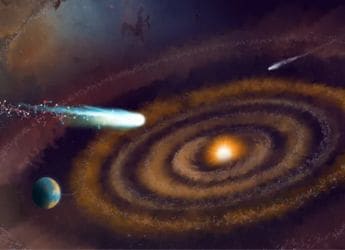- Home
- Science
- Science News
- NASA Experiment Shows Martian Ice Could Preserve Signs of Ancient Life
NASA Experiment Shows Martian Ice Could Preserve Signs of Ancient Life
NASA experiments show amino acids can endure millions of years frozen in Mars-like ice.

Photo Credit: NASA/JPL-Caltech/University of Arizona/Texas A&M University
NASA finds biomolecules can endure millions of years in Mars-like ice
In a recent report, it has been proposed that remnants of the ancient life as we know them may be trapped beneath the frozen surface of Mars. In test conditions, researchers had frozen the bacterial cells in pure water ice during Mars like conditions and subjected them to high doses of radiation. Amazingly, they discovered that the protein molecules (amino acids) were still viable tens of millions of years when they are isolated in pure ice.
Lab Tests Simulate Martian Ice
According to the study, scientists froze E. coli bacteria in two scenarios: a block of pure water ice and a similar block mixed with Martian soil. Both were cooled to roughly -60°F (-51°C) and bombarded with radiation matching 50 million years on Mars.
In the pure ice, over 10% of the amino acids survived this simulated exposure, but in the soil-bearing samples nearly all organic molecules decayed. In other words, pure ice protected the biomolecules, while minerals allowed radiation damage to spread.
Implications for Mars Exploration
According to the study by lead researcher Alexander Pavlov of NASA, pure ice, or the ice-rich areas adjacent to the surface, are considered ideal in the search of preserved biomolecules. The reason behind this is that a lot of the ice on Mars is relatively recent (most of it being less than 2 million years old), thus any ancient organics caught within ice would be preserved.
These ice reserves will probably be the focus of future missions with exercises or scoops, and the frozen layers of Mars will be the time capsules of its life.
For the latest tech news and reviews, follow Gadgets 360 on X, Facebook, WhatsApp, Threads and Google News. For the latest videos on gadgets and tech, subscribe to our YouTube channel. If you want to know everything about top influencers, follow our in-house Who'sThat360 on Instagram and YouTube.
Related Stories
- Samsung Galaxy Unpacked 2025
- ChatGPT
- Redmi Note 14 Pro+
- iPhone 16
- Apple Vision Pro
- Oneplus 12
- OnePlus Nord CE 3 Lite 5G
- iPhone 13
- Xiaomi 14 Pro
- Oppo Find N3
- Tecno Spark Go (2023)
- Realme V30
- Best Phones Under 25000
- Samsung Galaxy S24 Series
- Cryptocurrency
- iQoo 12
- Samsung Galaxy S24 Ultra
- Giottus
- Samsung Galaxy Z Flip 5
- Apple 'Scary Fast'
- Housefull 5
- GoPro Hero 12 Black Review
- Invincible Season 2
- JioGlass
- HD Ready TV
- Laptop Under 50000
- Smartwatch Under 10000
- Latest Mobile Phones
- Compare Phones
- Red Magic 11 Pro
- Red Magic 11 Pro+
- Huawei Nova Flip S
- Huawei Nova 14 Vitality Edition
- OPPO Find X9
- OPPO Find X9 Pro
- Honor Magic 8 Pro
- Honor Magic 8
- MacBook Pro 14-inch (M5, 2025)
- Asus Vivobook S16 (S3607QA)
- OPPO Pad 5
- Apple iPad Pro 13-inch (2025) Wi-Fi + Cellular
- OPPO Watch S
- Honor Watch 5 Pro
- Xiaomi Xiaomi TV S Pro Mini LED 55 2026
- Xiaomi TV S Pro Mini LED 65 2026
- Asus ROG Ally
- Nintendo Switch Lite
- Haier 1.6 Ton 5 Star Inverter Split AC (HSU19G-MZAID5BN-INV)
- Haier 1.6 Ton 5 Star Inverter Split AC (HSU19G-MZAIM5BN-INV)

















